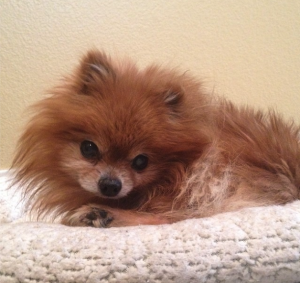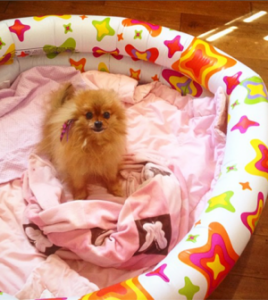Pomeranian puppy training can be either an arduous task or an exhilarating one, depending on how much time and patience you truly have. A few weeks ago, I found myself extremely frustrated with one of my members in the Pommy Mommies Facebook group. Typically, I’m a pretty patient person (try saying that five times fast) when it comes to answering questions about Pomeranian puppy training, but this situation pushed me to my limit.
This particular group member kept asking, “How do I stop my Pomeranian puppy from peeing on the couch and carpet?” My husband, myself, and at least 30 other people answered her repeatedly, with the same advice. “You need to restrict her movement around the house and keep her off the furniture. When you’re not able to supervise, it’s best to crate her or put her in a safe space like a playpen or small pen.” But the member refused to accept this solution, insisting she couldn’t afford a crate or pen.
At that point, I was truly annoyed. Pomeranian puppy training is important, and if you can’t provide the basic tools for housebreaking—or, as we Pommy Mommies like to call it, “potty training”—then maybe getting a Pomeranian, or any dog, isn’t the best idea. Puppies require structure, boundaries, and patience, which isn’t negotiable if you want a well-trained, happy Pomeranian.
Pomeranian Puppy Training: Why Boundaries Are Essential
 Pomeranians are a very special breed that require equally special care and training. They are intelligent, loyal, and full of energy, but without proper boundaries, this energy can quickly turn destructive. If you can’t afford the necessary tools to provide an appropriate home environment for housebreaking, it’s not just a problem for your puppy—it’s a problem for you.
Pomeranians are a very special breed that require equally special care and training. They are intelligent, loyal, and full of energy, but without proper boundaries, this energy can quickly turn destructive. If you can’t afford the necessary tools to provide an appropriate home environment for housebreaking, it’s not just a problem for your puppy—it’s a problem for you.
When it comes to training, one thing that is crucial is restricting movement in the early stages. Crates or playpens serve as safe spaces where puppies can’t get into trouble while learning their boundaries. Without proper containment, you run the risk of your puppy developing poor habits, like peeing on your furniture and carpets.
Potty training is one of the most important tasks you’ll take on when you get a Pomeranian puppy. But it’s not an impossible task—Pomeranians are incredibly smart and can pick up on commands quickly, often faster than many other breeds. If you invest the time and proper tools upfront, you’ll save yourself a lot of headaches down the road.
My Experience with “Little” Sophia and Creating a Safe Haven
 Let me introduce you to my PomChi, “Little” Sophia. She’s 13 years old now, and training her has been a unique journey. Sophia didn’t have the easiest start in life; her previous owners mistreated her, and she has lasting neurological damage as a result. Separated vertebrae expose her spinal cord, and she walks with locked legs because of luxating patellas. Yet, despite all her physical challenges, Sophia is full of life, always wanting to explore and get into mischief.
Let me introduce you to my PomChi, “Little” Sophia. She’s 13 years old now, and training her has been a unique journey. Sophia didn’t have the easiest start in life; her previous owners mistreated her, and she has lasting neurological damage as a result. Separated vertebrae expose her spinal cord, and she walks with locked legs because of luxating patellas. Yet, despite all her physical challenges, Sophia is full of life, always wanting to explore and get into mischief.
When it comes to potty training, Sophia doesn’t have accidents in the house because she’s trained to use potty pads, and I take her out regularly when she gives her little bark (which sounds like a baby seal!). But when we leave the house, I was filled with anxiety. I didn’t want her to wander around and hurt herself while we were gone, so we tried using a crate.
Unfortunately, the crate wasn’t working. Sophia frequently banged into the metal bars, and I feared she might injure her delicate spine or get her tiny paws stuck. My husband, ever the creative thinker, suggested we use an empty baby pool—yes, a pool with no water—as a solution. It was such a brilliant idea that I couldn’t believe I hadn’t thought of it sooner.
We lined the bottom of the pool with potty pads and blankets to give her traction and a soft space to move around. If she stumbled, the blankets cushioned her fall, and the plastic walls protected her from hurting herself. The pool gave her enough room to walk without being too overwhelming, and because she’s blind, she used the soft walls as a guide. It worked so well that we bought a smaller one for my husband’s office.
How a Simple Solution Can Make Training Easier
 Sophia’s setup made me realize that you don’t need expensive equipment to create a safe space for your Pomeranian puppy. A baby pool costs as little as $11.99 and can function as an alternative to a crate or playpen, especially for puppies or older dogs who need restricted movement.
Sophia’s setup made me realize that you don’t need expensive equipment to create a safe space for your Pomeranian puppy. A baby pool costs as little as $11.99 and can function as an alternative to a crate or playpen, especially for puppies or older dogs who need restricted movement.
Back to my original story: to the woman who said she couldn’t afford a crate, my suggestion is simple—buy a cheap baby pool! It’s a small investment that can save you time, stress, and effort in the long run. A pool creates boundaries, helps with potty training, and gives your Pomeranian a comfortable place to learn the rules of your home. Puppies need these boundaries to establish good habits and to feel secure in their space.
Pomeranian Puppies: Smart and Quick Learners
Pomeranians show exceptional intelligence, and I may be biased, but they pick up commands and training faster than most other breeds. If you give them structure—whether it’s a crate, baby pool, or playpen—they’ll quickly understand where to go and what’s expected of them.
I can’t stress enough how much better I felt leaving “Little” Sophia in her makeshift pool haven. Knowing that she’s safe, comfortable, and has her boundaries has lifted a weight off my heart. The same goes for training any Pomeranian puppy—it’s all about providing the right environment and taking the time to teach them good habits.
Final Thoughts on Pomeranian Puppy Training
Pomeranian puppy training doesn’t have to be stressful or overwhelming, but it does require commitment, structure, and a willingness to invest in the proper tools. Whether you use a crate, a playpen, or even a baby pool, creating a safe space for your puppy is essential to their well-being and success in training.
If you’re a new Pommy Mommy or Daddy, remember that puppies are incredibly fast learners when given the proper boundaries. And if you’re ever in a bind, don’t be afraid to think outside the box—sometimes, the simplest solutions, like a baby pool, can provide the peace of mind and safety your Pomeranian needs.
Related Posts:
A DIY Pomeranian Harness to help “Little” Sophia’s Mobility
Stop Pomeranian Puppy Biting with This Effective Technique
Training Your Pomeranian: Raising a Well-Behaved Pom
